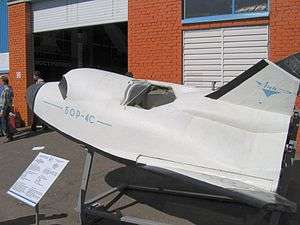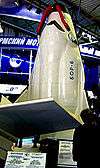Mikoyan-Gurevich MiG-105
| MiG-105 | |
|---|---|
| | |
| MiG 105-11 test vehicle at the Monino Air Force museum.[1] | |
| Role | Test vehicle |
| Manufacturer | Mikoyan-Gurevich |
| First flight | 1976 |
| Status | Cancelled |
| Primary user | Soviet Air Force |
|
| |
The Mikoyan-Gurevich MiG-105 part of a program known as the Spiral (aerospace system) was a manned test vehicle to explore low-speed handling and landing.[2] It was a visible result of a Soviet project to create an orbital spaceplane. This was originally conceived in response to the American Boeing X-20 Dyna-Soar military space project and may have been influenced by contemporary manned lifting body research being conducted by NASA's Flight Research Center in California. The MiG 105 was nicknamed "Lapot" Russian: лапоть, or bast shoe (the word is also used as a slang for "shoe") for the shape of its nose.
Development
The program was also known as EPOS (Russian acronym for Experimental Passenger Orbital Aircraft). Work on this project finally began in 1965, two years after Dyna-Soar's cancellation. The project was halted in 1969, to be briefly resurrected in 1974 in response to the U.S. Space Shuttle Program. The test vehicle made its first subsonic free-flight test in 1976, taking off under its own power from an old airstrip near Moscow. It was flown by pilot Aviard G. Fastovets to the Zhukovskii flight test center, a distance of 19 miles. Flight tests, totaling eight in all, continued sporadically until 1978. The actual space plane project was cancelled when the decision was made to instead proceed with the Buran project. The MiG test vehicle itself still exists and is currently on display at the Monino Air Force Museum in Russia.
Gleb Lozino-Lozinskiy was the leader of the Spiral development programme.
Differences between Dyna-Soar and Spiral
Although having basically the same mission, Dyna-Soar and Spiral were radically different vehicles. For example:
- While the X-20 Dyna-Soar was designed for launch atop a conventional expendable rocket such as the Titan III-C or Saturn I, Soviet engineers opted for a midair launch scheme for Spiral. Known as "50 / 50", the idea was that the spaceplane and a liquid fuel booster stage would be launched at high altitude from the back of a large, airbreathing mothership travelling at hypersonic speeds. The mothership was to have been built by the Tupolev Design Bureau (OKB-156) and utilize many of the same technologies developed for the Tu-144 supersonic transport and the Sukhoi T-4 Mach 3 bomber. It was never built.
- Dyna-Soar was designed as a lifting body, while Spiral was a conventional delta that featured an innovative variable-dihedral wing. During launch and reentry, these were folded upward at 60 degrees. After dropping to subsonic speeds post-reentry, the pilot lowered the wings into the horizontal position, giving the spaceplane better re-entry and flight characteristics.
- Spiral was built to allow for a powered landing and go-around maneuver in case of a missed landing approach. An air intake for a single Kolesov turbojet was mounted beneath the central vertical stabilizer. This was protected during launch and re-entry by a clamshell door which opened at subsonic speeds. By comparison, Dyna-Soar was designed primarily for a once-off, unpowered deadstick landing.
- High temperature superalloy metals such as niobium, molybdenum, tungsten and rene 41 were to have been used in the heatshield structure of the X-20. Spiral was to have been protected by what Soviet engineers termed "scale-plate armour": niobium alloy ВН5АП and molybdenum disilicide plated steel plates mounted on articulated ceramic bearings to allow for thermal expansion during reentry. Several BOR (Russian acronym for Unpiloted Orbital Rocketplane) craft were flown to test this concept.
- In the event of a booster explosion or in-flight emergency, the crew compartment of Spiral was designed to separate from the rest of the vehicle and parachute to earth like a conventional ballistic capsule; this could be done at any point in the flight. Such an escape crew capsule was also considered for Dyna-Soar, but American engineers eventually opted for a solid-fuel escape rocket that would kick the spaceplane away from an exploding booster, hopefully saving both pilot and spacecraft.
- Much like the Space Shuttle, Dyna-Soar was designed with a small payload bay behind the pressurized crew module. This could be used for lofting small satellites, carrying surveillance equipment, weapons or even an extra crewmember in a pop-in cockpit. Spiral, on the other hand, was intended to carry only its pilot.
- Both Dyna-Soar and Spiral were designed to land on skids. The landing skids on Dyna-Soar were designed to deploy from insulated doors on the underside of the vehicle, like a conventional aircraft. Soviet engineers designed the landing skids on Spiral to deploy from a set of doors on the sides of the fuselage just above and ahead of the wings.
Pilots

A cosmonaut training group for pilots assigned to fly this vehicle was formed in the early 1960s. It went through many changes and was eventually dissolved entirely. Known members included:
- Gherman Titov, the second man to orbit the Earth (see Vostok 2 mission).
- Vasily Lazarev, Cosmonaut who would later fly the first Soyuz 7K-T mission (see Soyuz 12)
- Aviard G. Fastovets, who piloted the vehicle during the majority of its atmospheric tests.
BOR
The БОР (Russian: Беспилотный Орбитальный Ракетоплан, Bespilotnyi Orbital'nyi Raketoplan, "Unpiloted Orbital Rocketplane"). Another spacecraft to use the Spiral design was the BOR series, unmanned sub-scale reentry test vehicles. American analogs X-23 PRIME and ASSET. Several of these craft have been preserved in aerospace museums around the world.
| Image | Type | Launch date | Usage | Current status |
|---|---|---|---|---|
| BOR-1 | 15.07.1969 | Flight test, the experimental 1:3 scale model. Burned in the atmosphere at a height of about 60–70 km with the speed 8 000 mph (13 000 km/h). Was deployed at an altitude 328,083 ft (100 km) by 11K65 | Burned (planned). | |
 | BOR-2 | 1969–1972 | Sub-scale model of the Spiral space plane. 4 launches. | NPO Molniya, Moscow |
| BOR-3 | 1973–1974 | Sub-scale model of the Spiral space plane. 2 launches. 1. Destruction of the nose fairings after launch at a height of about 5 km (speed 0.94 Mach). 2. Flight program is fully implemented. Crashed on landing (Parachute failure) | Crashed. | |
 | BOR-4 | 1980–1984 | Sub-scale model of the Spiral space plane. 4 launches and 2 unconfirmed | NPO Molniya, Moscow |
| | BOR-5 | 1984–1988 | Flight tests, the experimental sub-scale base model. 5 launches. Different from Spiral spaceplane shape, data was also used in the Buran project. | Technik Museum Speyer, Germany Museum in Monino, Russia |
 | BOR-6 | Sub-scale model of the Spiral space plane | NPO Molniya, Moscow |
Operators
Specifications (MiG 105-11)
Data from Soviet X-planes; Yefim Gordon, Bill Gunston
General characteristics
- Crew: 1
- Length: 10.6m (including instrument boom) (34 ft 9 in)
- Wingspan: 6.7m (21 ft 12 in)
- Height: m (ft in)
- Wing area: 24m² (258ft²)
- Empty weight: 3,500 Kg (7,716 lb)
- Useful load: Kg (lb)
- Loaded weight: 4,220 Kg (9,303 lb)
- Max. takeoff weight: Kg (lb)
- 500 Kg Fuel
Performance
- Never exceed speed: km/h (knots, mph)
- Maximum speed: 800km/h (432 knots, 500 mph)
- Cruise speed: km/h (knots, mph)
- Stall speed: km/h (knots, mph)
- Range: km (nm, mi)
- Service ceiling: m (ft)
- Rate of climb: m/s (ft/min)
- Wing loading: 175 kg/m² (lb/ft²)
Landing speed 250-270 km/h ( 155-168 mph )
See also
- Aircraft of comparable role, configuration and era
References
External links
| Wikimedia Commons has media related to Mikoyan-Gurevich MiG-105. |
- Predecessor of Shuttle and Buran: Spiral Orbital Aircraft Programme
- Spiral and EPOS project
- Spiral OS
- Spiral 50-50
- Spiral, MIG 105, Uragan
